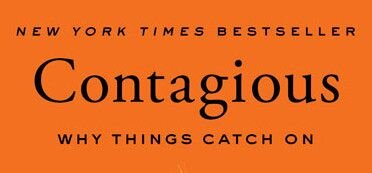My journey through marketing books: “Contagious”
Why you should care about “Contagious”: If you’re a business owner or marketer, then you spend a lot of your time trying to get noticed by potential customers. This book can help you create content that’s engaging and made to go viral.
“Virality isn’t born, it’s made.”
Why this book review is different
Reading books is often touted as one of the best ways to excel in your field. But, while many books are beneficial, not all of us have the same workflow or creative process. Some may be looking for a how-to book that lists the steps, while others want a book that helps them see the bigger picture and develop their own ideas.
In this series, I’ll document my journey through some of the highest-rated marketing books. I won’t be leaving a critical review of the author’s voice, grammar, or other things book reviewers tend to focus on. Instead, I’ll talk about what I found useful for marketing and how I plan to use the information. My goal is to help you along your learning journey as I share how I’m benefiting from mine.
“Contagious content is like that—so inherently viral that it spreads regardless of who is doing the talking.”
"Contagious: Why Things Catch On" by Jonah Berger
I chose “Contagious” because I’m constantly confronted with the challenge of making things stand out as a marketer. The problem is that we all compete in a sea of advertising, brands, and marketing efforts. So naturally, I was intrigued when I read the title of Jonah’s book.
A short point about the way I like to read marketing books: while I like the practical points they offer, I enjoy their role as a thought catalyst even more. What do I mean by this? As I read or listen to a book, I like to let my mind wander with interesting points and see where it takes me. This has often led to refinements in how we do things at The Content Reactor and helped me come up with ideas for new services.
“If something is built to show, it’s built to grow.”
A roadmap for creating viral content
“Contagious” is based on six principles or steps to creating contagious content. These include social currency, triggers, emotion, public, practical value, and stories. Instead of giving you a to-do list that you can follow when creating contagious ideas, he uses these 6 points as guidelines for creating sticky content.
Jonah uses plenty of real examples like Blendtec blending marbles and how airline miles make people loyal to back up his principles. These examples help you think about how the principles can work for your business. While some of the points may seem like common sense for a marketer, he does a good job of showing the relationship between the six principles, which gives you a clear roadmap for making your next idea catchy.
I would put this book in a similar category to "Made to Stick," by the Heath Brothers, which Jonah cites as an inspiration. If you read and benefited from that book, then you’ll enjoy this one too.
“People don't need to be paid to be motivated.”
What "Contagious" taught me about emotion
Emotion: Emotion was my favorite point because Jonah showed how you could harness emotion to make a seemingly boring topic interesting and contagious. My favorite example was Denise Grady’s writing on how fluid and gas dynamic theories were being used in medical research. In her article, "The Mysterious Cough, Caught on Film," Grady wanted to give people a “eureka moment” by making this difficult topic super easy to understand. By doing this successfully, she evoked awe in her readers (which Jonah talks about) and created a viral article. If she could make that topic go viral, then the rest of us shouldn’t have a problem.
Game mechanics: Jonah talked about how game mechanics could boost adoption because it increases the likelihood that people will share it with others in their peer group. I found it interesting that the user’s perception of a boost in their status among peers could be a bigger incentive than a monetary reward.
Stories: Recently, storytelling has become a buzzword in the content marketing industry. Even so, content is still not written in story form very often. This is probably because it takes research to find the right example for your story, and content production is often underfunded. But Jonah shows how wrapping your message in a story can get you past people’s natural dislike for advertising.
“Marketing is about spreading the love.”
What I’m excited to use
As a content marketer for B2B companies, I think it can be easy to overlook the importance of emotion and storytelling when writing. The assumption is that people want the facts with no fluff. But business owners are people too, and they want to use companies with values similar to their own. I’m excited to continue working on my storytelling ability and improving how I use it to build the brands I work on, including my own.
“People don’t think in terms of information. They think in terms of narratives. But while people focus on the story itself, information comes along for the ride.”
3 ways marketers can apply the lessons from "Contagious"
Harness emotion in your communications. This one may seem obvious, but it’s so important that it needs to be first. If your article doesn’t evoke an emotional response, it may be time to go back to the drawing board.
Tell people why your product is special. In "Contagious," Jonah shares how Blendtec made a blender special by blending crazy things on YouTube. This led to massive growth with almost no marketing budget. Find what makes you unique and run with it.
Find stories that make your content relatable. Great topics include "10 tips for doing something," but if you can wrap those tips in stories, it’s even better. Seeing how real people use advice and benefit from it is much more powerful than the advice alone.
Thanks for reading! If you liked this article and recommend that I review a specific business book, leave it in the comments below. Or if you just want to talk about your marketing challenges, that’s cool too. Just shoot me an email, and I’ll get back to you at the speed of the internet.



